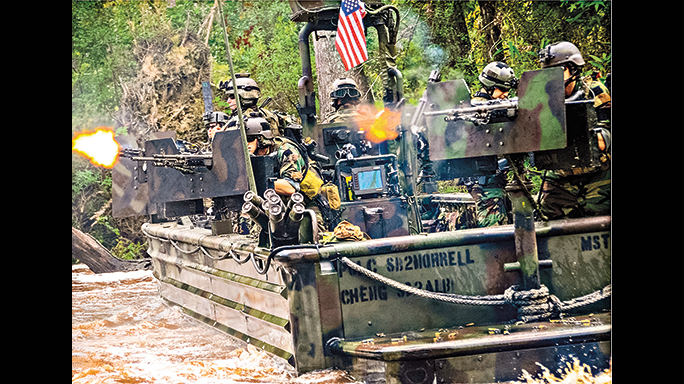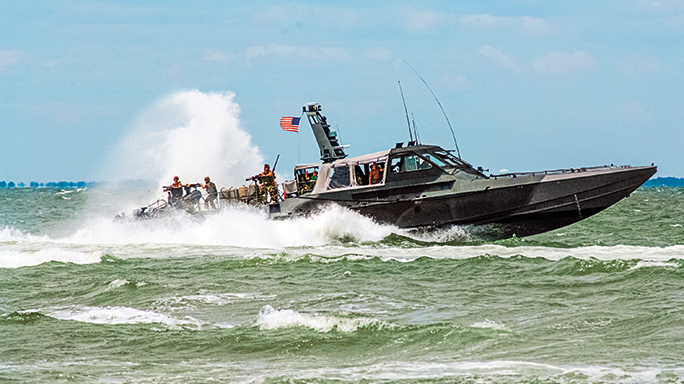Special Operations forces are trained to perform wherever hostilities call, on land, in the air, and above or below the surface of water. Their duty requires sophisticated transportation options, for insertion and extraction and for in-mission mobility. Vehicles available for each SOF mission are adapted and designed to provide maximum firepower, speed, stealth, and armor, plus advanced mobile communication and integrated computing equipment.
LAND
Ground Mobility Vehicles (GMVs):
The U.S. military has used variations of the Humvee since the 1989 invasion of Panama. Based on the lessons learned in Operation Desert Storm in 1991, SOF added heavier suspensions, rugged tires, improved ground clearance, an open bed, removable armor plating, and a towing winch to the nearly three-ton 4×4.
Advertisement — Continue Reading Below
- RELATED STORY: DARPA’s GXV-T Concept Leads Next-Gen Military Vehicles
A 12-man Operational Detachment Alpha (ODA) will typically patrol with four GMVs, which can be mounted with .50-caliber machine guns, belt-fed machine guns, grenade launchers, and SAW 5.56 machine guns. The GMV has a cruising range of 275 miles, allowing forces to operate far behind enemy lines. Operators undergo extensive training in in-field repairs and off-road handling.
Ranger Special Operations Vehicles (SOVS):
Based on the Land Rover 100, the Ranger SOV is a light attack vehicle that can be transported by helicopter, and it’s vital for the 75th Ranger Regiment. The 4×4 Ranger SOV is smaller than the Humvee, giving it greater mobility. It carries seven Rangers and can be mounted with .50-caliber machine guns, belt-fed machine guns, and 40mm grenade launchers. Rather than functioning as a general attack vehicle, the Ranger SOV is used to quickly apply force to specific locations on a battlefield. The vehicles can be modified to serve as a weapons carrier, medical vehicle, or communications hub. The Ranger SOV replaced the standard Army Jeep in 1992.
Nonstandard Tactical Vehicles (NSTVS):
Early in the Afghanistan war, Special Ops forces got their hands on Toyota Hilux flatbed pickups, which they jerry-rigged with machine gun mounts. Because the commercial version of the trucks were widespread among the local populations, the SOF attracted little notice, could move with greater stealth, and spare parts were easy to find. Later, U.S. Special Operations Command purchased Toyota Tacomas and modified them with belt-fed machine gun mounts, grenade launchers, roll bars, infrared headlights, satellite communications, and tracker units.
Advertisement — Continue Reading Below
Light Medium Tactical Vehicles (LMTV), “WAR PIGS”:
The war pig serves as a mothership for groups of GMVs operating far from a supply base. The 2.5-ton truck is stripped to bare essentials so it can be loaded with ammunition, fuel, and supplies needed by the group for the mission. It is fitted with mounts for .50-caliber machine guns, belt-fed machine guns, and grenade launchers.
Armored Ground Mobility Systems (AGMS):
The 6×6 armored personnel carrier transports seven troops plus a commander and driver. It is primarily used by Delta Force, but is in limited use by Rangers as well. The vehicle replaces light armored vehicles for direct action missions, when shielded vehicles are needed to protect troops being transported to battle locations. The AGMS features a shielded mount on the roof for a .50-caliber machine gun or grenade launcher, shielded driver’s compartment, custom armor kit, electronic anti-IED measures, and secure radio system.
Motorcycles:
Although 4×4 quad bikes and ATVs serve some of the same purposes, motorcycles are still favored by some Delta, Rangers, SEAL, and Green Beret units because of their speed, mobility and stealth. The most commonly used bikes are the Kawasaki KLR 250-D8, Kawasaki M1030, and Christini all-wheel-drive bikes. Common modifications include infrared headlights, bracket to hold a weapon, infrared camo paint that conceals the vehicle from night-vision goggles at night as well from normal vision during the day, and run-quiet mufflers.
Advertisement — Continue Reading Below
All-Terrain Vehicles (ATVS):
The four- and six-wheeled vehicles are mobile, small, and fast, and perfect for recon and insertion of troops. Although they do not offer ballistic protection, ATVs can easily be hidden, and they can maneuver in tight locations where trucks or other vehicles cannot penetrate. ATVs are typically fitted with run-quiet mufflers and infrared headlights. The Polaris MVRS800 has a multi-fuel engine with a sealed power train, allowing it to operate in as much as 30 inches of water.
AIR
CV-22 Ospreys:
The CV-22 Osprey is one of the most versatile machines in the Special Ops arsenal. The tilt-rotor aircraft can hover, take off, and land vertically like a helicopter, then fly forward like a turboprop plane by simply rotating the engines and prop-rotors to a forward position. Thanks to its design, the Osprey regularly performs missions that normally require both fixed-wing aircraft and helicopters.
Advertisement — Continue Reading Below
- RELATED STORY: Ohio Law Enforcement Agencies Adding Military Vehicles
Primarily, the Osprey conducts long-range infiltration, exfiltration, and resupply missions. It can take off vertically with 24 troops or 10,000 pounds of cargo, and it is equipped with missile countermeasures, terrain-following radar, and forward-looking infrared sensors. For search-and-rescue missions, the Osprey is fitted with rope ladders, a rescue winch, and a survivor locator. It can be armed with .50-caliber machine guns and a GAU-17 minigun in the remotely operated belly turret.
AC-130 Spectre/Spooky II Gunships:
USAF special ops forces use the heavily armed long-endurance craft for three types of missions: close air support roles, including supporting ground troops, escorting convoys, and urban operations; air interdiction missions conducted against planned targets and targets of opportunity and force protection missions, including the defense of air bases.
The aircraft’s weapons are integrated with sensors, navigation, and fire control systems, which are capable of delivering area-saturation fire over a long period of time. Weapons are fired from the port side, which means the gunship attacks by making a sweeping turn, allowing the guns to stay trained on the target for a long time. Typical weapons may include a 40mm autocannon, 105mm howitzer, 25mm GAU-12/U Equalizer, 30mm Bushmaster cannon, missiles, and small-diameter bombs.
Advertisement — Continue Reading Below
The AC-130 has been in operation since the Vietnam War. The latest version is known as the AC-130J Ghostrider, and it features infrared and electro-optical sensors and GBU-39 small-diameter bombs mounted on the wings.
MC-130J Commando II:
The Commando II flies clandestine, low-level refueling and resupply missions when the special operation must intrude over politically sensitive or hostile lands. It is particularly adept at nighttime missions, and was designed for use by SOF.
The tech features of the Commando include integrated digital avionics, 13-color LCDs, an integrated navigation system, six-bladed composite propellers, satellite communications for voice/data, and missile-spoofing laser for defense. The Commando has a wingspan of 130 feet, travels at 417 miles per hour, and has a range of 3,000 miles and a maximum altitude of 28,000 feet.
Advertisement — Continue Reading Below
MH-60 Black Hawk Helicopters:
The standard UH-60 is the Army’s utility helicopter, but modified versions of the Black Hawk are used by SOF for insertion and extraction in hostile areas, day or night, in all weather conditions. Other versions are used for resupply and personnel location, and as a gunship with serious firepower. Basic configurations include radar warning, infrared jammers, fare/chaff dispensers, and a personnel location system that tracks a signal from a distress system. Black Hawks also may carry electrically operated, air-cooled Gatling guns, rocket pods, Hellfire laser-guided missiles, and a laser designator that can illuminate targets for the missiles.
MH-47 Chinook Helicopters:
The twin-engine, tandem-rotor Chinook is the primary heavy-lift transport helicopter for the Army’s 160th Special Operations Aviation Regiment (SOAR). The basic architecture of the Chinook was introduced in 1962, and modified versions are scheduled for production until at least 2030.
- RELATED STORY: 6 Must-See Vehicles at the American Military Museum
Chinooks are used for overt and covert parachute, fast-rope, and water insertions, and they excel in every climate and condition. They are one of the few aircraft that can perform in high-altitude regions of Afghanistan. Utilizing multimode radar and forward-looking infrared sensors, Chinooks can fly nearly 150 miles per hour just a few feet off the ground, day or night, in any weather.
Advertisement — Continue Reading Below
The Chinook is also invaluable for its ability to shift personnel, equipment, and supplies rapidly over large areas.
SEA
Special Ops Craft–Riverine (SOC-R):
When SEALs need quick insertion or extraction along river networks or coastal areas, their go-to craft is the SOC-R. The boat is fitted with ballistic protection for the engine, helmsman, and gunners. It is also surprisingly high-tech, with GPS, satellite communications, and the ability to electronically identify friend or foe. It can transport eight SEALs plus crew at speeds of more than 45 mph. And if the enemy happens to pop up and cause trouble, the three crewmen can unleash plenty of firepower, including .50-caliber machine guns, belt-fed machine guns, grenade launchers, and M134 7.62mm miniguns.
Advertisement — Continue Reading Below
Combat Rubber Raiding Craft (CRRC):
Final insertion of as many as 10 commandos is often carried out by inflatable Zodiacs, in part because they are lightweight and portable and can be delivered by helicopter, cargo planes, boats, and even submarines. The Zodiacs are powered by run-silent outboard motors, or by paddles when extreme stealth is necessary.
Diver Propulsion Devices (DPD):
Underwater mobility platforms enable military divers to travel more than seven miles for clandestine amphibious infiltration, quickly and with little physical effort. The DPD typically carries two men and equipment on the surface or as deep as 115 feet. The device is powered by a lithium battery connected to an electric motor.
Mark V Spec Ops Craft (MK V SOC):
The MK V SOC looks like something Batman would pilot to protect Gotham City. It is dark gray, menacing, loaded with firepower, and designed with plenty of angles to defect radar signals. The Mark V is often used as a mothership, carrying a crew of five plus 16 SEALs and four Zodiacs to an insertion point. A ramp at the stern facilitates rapid launch and recovery of either Zodiacs or DPDs.
The MK V SOC is also equipped with five weapon mounts, for .50-caliber machine guns, belt-fed machine guns, grenade launchers, and M134 miniguns.
- RELATED STORY: Combat Vehicles: Sikorsky’s SB-1 Defiant Helicopter
































